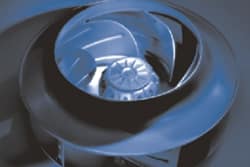Showing all 2 results
-
Ebm-papst Backward & Forward Curve Radials
$0.00 Read more -
Ziehl-Abegg Mixed Flow & Backward Curve Radials
$0.00 Read more
Radial Fan Assemblies
Radial fan assemblies, also known as centrifugal fan assemblies, are a type of mechanical equipment used for moving air or gas in various industrial and commercial applications. These assemblies consist of a radial fan, an electric motor, and a housing that encloses and supports the fan and motor components.
The primary function of a radial fan assembly is to generate a high-pressure airflow by converting the rotational energy from the motor into kinetic energy. This is achieved through the radial design of the fan blades, which draw air in axially and then propel it outward in a radial direction. The resulting airflow is highly efficient and capable of overcoming resistance, making radial fan assemblies suitable for applications where moderate to high static pressures are required.
Radial fan assemblies find wide application across different industries, including HVAC (Heating, Ventilation, and Air Conditioning), industrial ventilation, dust collection systems, process cooling, pneumatic conveying, and more. They are commonly used for tasks such as air circulation, exhaust ventilation, fume extraction, cooling of equipment or processes, and maintaining optimal air quality in enclosed spaces.
These fan assemblies are available in a range of sizes, configurations, and materials to meet specific application requirements. The fan blades can have various shapes and arrangements, such as forward-curved, backward-curved, or straight blades, each offering different performance characteristics in terms of airflow volume, pressure generation, and energy efficiency.
Features and options commonly found in radial fan assemblies include adjustable speed controls, dampers or louvers for airflow regulation, sound attenuation measures, corrosion-resistant coatings, and spark-resistant construction for hazardous environments. The assemblies may also incorporate additional components like inlet or outlet cones, diffusers, or plenums to optimize airflow patterns and enhance performance.
When selecting a radial fan assembly, factors such as airflow requirements, pressure needs, noise levels, power consumption, and the surrounding environment should be considered. Proper installation, maintenance, and periodic inspections are crucial to ensure optimal performance, reliability, and longevity of the fan assembly.
In summary, radial fan assemblies are essential equipment for moving air or gas efficiently in industrial and commercial settings. Their ability to generate high-pressure airflow makes them versatile and valuable across various applications, contributing to improved ventilation, temperature control, and air quality in diverse environments.




